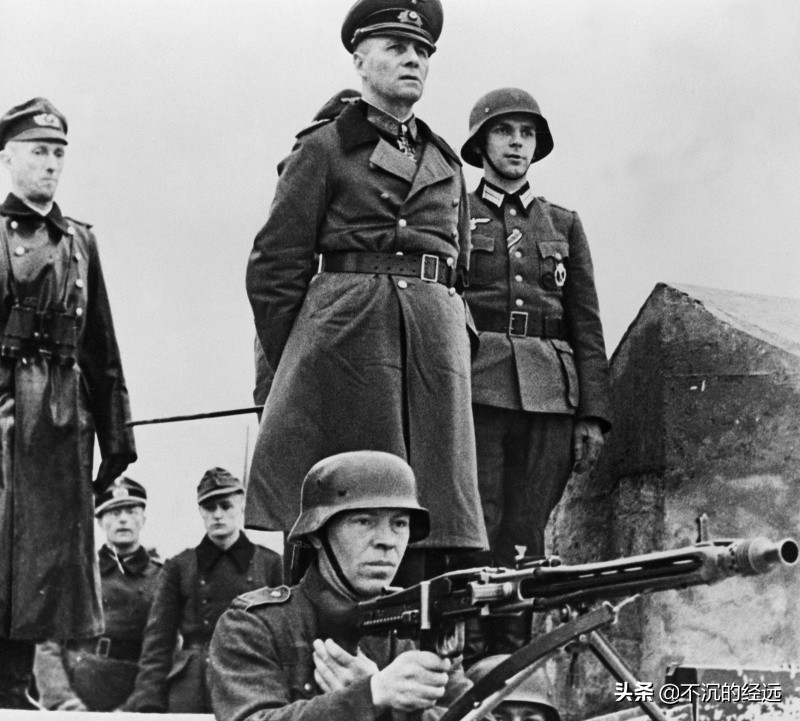In December 1943, Rommel was transferred to France to build coastal fortifications against an imminent Allied landing attack. In January 1944, Rommel was officially appointed commander-in-chief of Army Group B, commanding the 7th and 15th Armies, and also mastering almost all the field forces on the Western Front, becoming the main military commander of the Allied forces defending the Western Front. However, not long after Rommel took office, he had a conflict with the commander-in-chief of the German army on the Western Front, Londersted, over how the armored forces were deployed.

Lundsted believed that it was unclear where the Allies would launch the landings now, so the German armored forces on the Western Front should be deployed in the rear, and after the Allies landed, they would know where their main offensive line was, and then use the mobility of the armored forces to launch a counterattack and give the Allies a fatal blow. This proposal was supported by Schweppenburg, commander of the Western Front's panzer group.
Rommel thought it would be difficult to fight if the Allies could not be driven into the sea on the first day of the landing and waited for the Allies to gain a foothold. Moreover, according to their own experience in fighting with the United States and the British in North Africa, the Allies have absolute air superiority, and if the armored forces are deployed in the rear, it is difficult to rush to the battlefield in time under the air raids of the Allies, which is bound to delay the fighters, so it is believed that the armored forces should be deployed near the beachhead positions in order to launch a counterattack in time.
Hitler, having listened to The opinions of Rondstedt and Rommel, could not be dissuaded for a moment, so he sent Guderian to the front to decide who to listen to. When Guderian arrived at the front, he believed that the Allies had the advantage of sea and air, and if the armored troops were deployed near the beachhead, they would inevitably be seriously hit by Allied fire, so they also advocated putting them in the rear.
After the tripartite opinions were summarized and reported to Hitler, Hitler thought that everyone had a certain truth, so he finally made a compromise decision to give three of the seven armored divisions to Rommel and deploy them near the beachhead, while the remaining four were led by Schweppenburg, commander of the Panzer Group on the Western Front, and deployed in the rear.
Judging from the results of the historical Normandy landings, the German armored forces deployed in the rear did not arrive at the beachhead in time to participate in the battle, and the German armored forces on the front line were also weak in strength, and the counterattack launched by the Allies was quickly repelled by the Allies, and Rommel's fears became a reality. But this does not mean that it is right to deploy armored forces on the front lines, as Rommel envisioned.
First of all, Guderian's fears were not unreasonable, and the Allies invested a large number of aircraft and warships for fire support in order to ensure the success of the landing. If the armored forces were really deployed on the front line, it was likely to be the focus of the Allied forces at the first time, and the losses were heavy. Historically, the German army did not eat less similar hardships.
Secondly and more importantly, Rommel misjudged the Allied landing sites, believing that the Allies were mainly in Calais, so he placed two of the three panzer divisions he commanded in Calais, and only the 21st Panzer Division was deployed in Caen in the Normandy region. Even after the Allied landings were launched, Rommel feared for a long time that the Allies were launching a feint attack in Normandy, and was reluctant to put the 15th Army into battle just in case.
Since Rommel was bent on believing that Calais was the real target of the Allied attack, even if he handed over seven armored divisions to him, the maximum number of armored divisions actually deployed in Normandy was only two or three, and he would not easily mobilize the troops deployed in Calais to come to reinforcements, which was obviously not enough to cope with such a large-scale Allied offensive. And even if Rommel wanted to transfer troops from Calais to Normandy, it would be difficult to get there in time under Allied air strikes, just like the armored forces deployed in the rear in history.
In addition, Rommel was also wrong about the timing of the Allied landings, and on June 4, he thought that the Allies would not attack for a short time, so he rushed back to Germany to celebrate his wife's birthday, which led to the fact that he was not at the front when the battle began. The commander of the 21st Panzer Division, General Vohindinger, also took a group of his officers to Paris for a vacation, and when the Battle of Normandy broke out, the 21st Panzer Division also lacked a commander and was difficult to directly enter the battle.
So even if the German army really deployed the armored troops on the front line as Rommel envisioned, there would not be too many armored troops in Normandy, coupled with the wrong judgment of the landing time and the negligence of precautions, the German army would eventually be unable to escape the end of defeat.